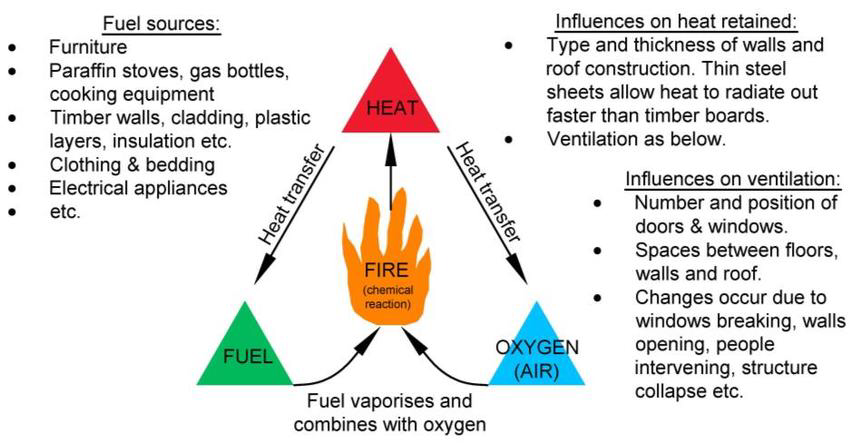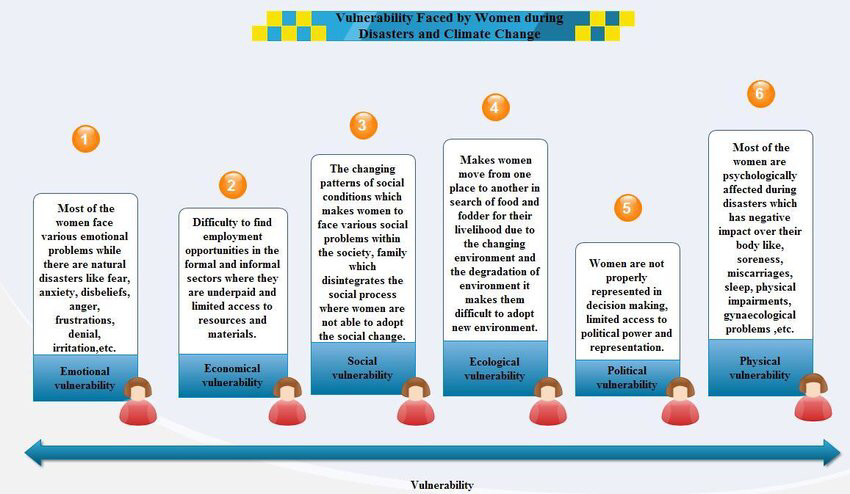10 May
Global Population growth and Sustainable development
Why in news? India surpasses China to become world’s most populous nation
Background:
- The world’s population, which numbered around 7.8 billion in 2020, has been growing rapidly and could rise to almost 11 billion by the end of the twenty-first century.
- It is estimated that by 2030, which is the target date for achievement of Sustainable Development Goals (SDGs), the population could climb to 8.5 billion.
- The size of the global population is expected to stabilise around 2100, bringing an end to the current era of rapid growth that began around 1800 in some regions and in the middle of the twentieth century on a global scale.
Why population growth matters for sustainable development ?
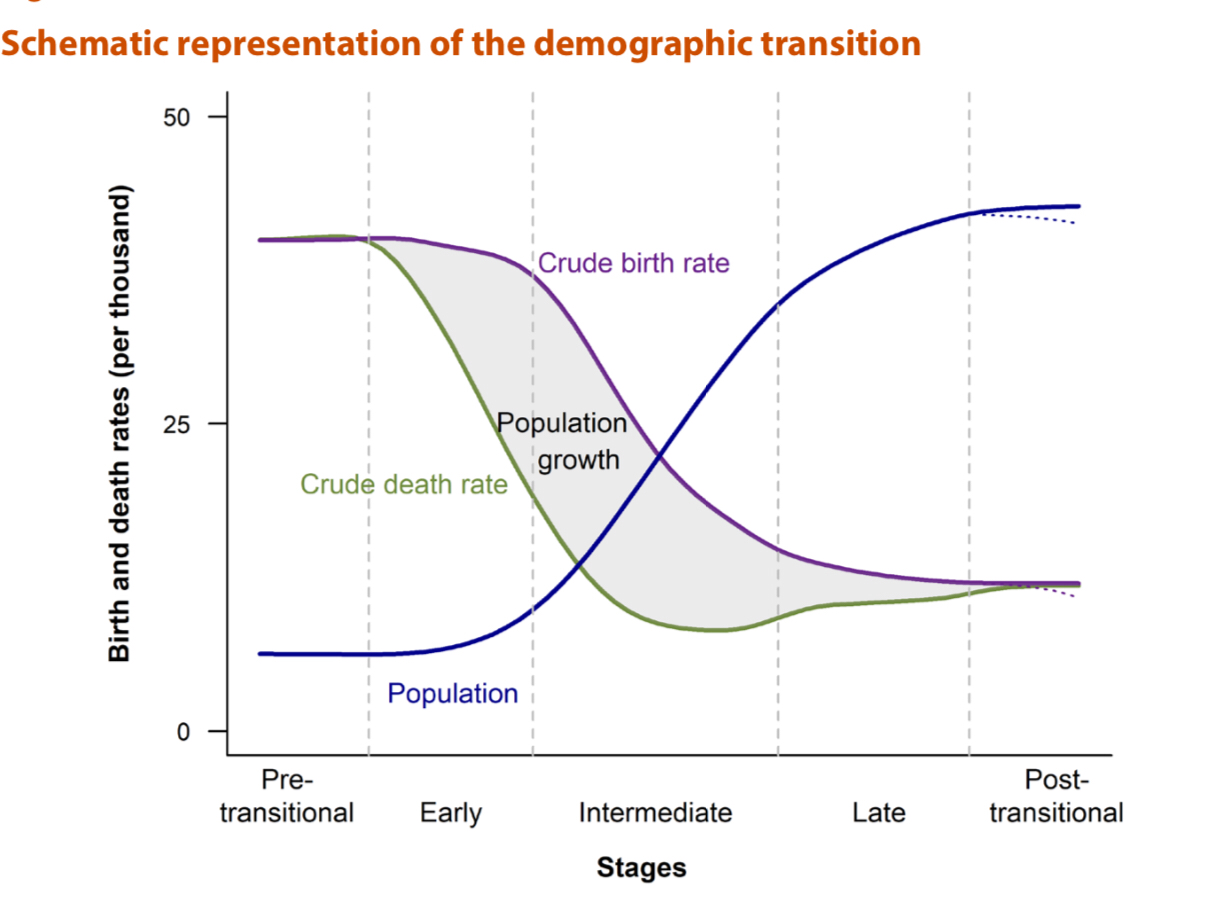
- Rapid population growth is both a cause and a consequence of slow progress in development. In low-income and lower-middle-income countries like Kenya, Bangladesh rapid population increase may slow progress in reaching certain Goals and targets of the 2030 Agenda for Sustainable Development
- Continuing growth of population in resource-poor settings enlarges the scale of existing challenges, such as eradicating poverty, ending hunger etc.
- It may also add to the difficulties of ending preventable and treatable diseases and conditions, ensuring inclusive and equitable education and schooling, and promoting full and productive employment and decent work for all.
- In Sub Sahara region , rapid rise in public expenditures on a per capita basis will be needed to eradicate poverty, end hunger and malnutrition, and ensure universal access to health care, education and other essential services.
- For Small Island Developing States (SIDS), the challenges of achieving sustainable development in the context of a rapidly growing population are compounded by their vulnerability to the adverse impacts of climate change, including rising sea levels.
Population growth & its drivers
- Fertility rates: Population growth is highly dependent on trends in fertility rates. The global fertility level is expected to decline from 2.5 children per woman in 2019 to 2.2 in 2050, according to the World Populations Prospects study from the UN.
- Mortality rates : Decline in mortality has led to an increase in population. With advancements in medicine , man has found cures to previously fatal diseases like Cancer. Medical boon has brought with it, the curse of overpopulation.
- Increase in longevity : Life expectancy has increased considerably in recent decades and this trend is set to continue: the forecast is to reach 77.1 years in 2050 (currently around 73).
- Early marriage: Many individuals are pressured into marriage by society at a very early age leading to an increased population.
- Child Labour : The children being seen as a source of income by impoverished families begin work too young and also lose the educational opportunities reflected, particularly when it comes to birth control.
- Poor Contraceptives Use : A study by the World Health Organization (WHO) shows that women aged between 16 and 49 years used at least one form of contraceptive are 43% in underdeveloped countries, which leads to higher birth rates.
- International migration : This is a less influential factor but countries that received large numbers of refugees or economic migrants (between 2010 and 2020, fourteen countries or areas had, a net inflow of more than one million) may offer a longer life expectancy to newcomers.
- Agricultural Advancements : Agricultural advancements in the 20th century have allowed humans to increase food production using fertilisers, herbicides, and pesticides and yields further. This allowed humans with more access to food that leads to subsequent population explosions. Eg . Green revolution .
Consequences of Exponential Population growth
- Degradation of Environment : With the overuse of coal, oil, and natural gas, it has started producing some serious effects on our environment. Besides, the exponential rise in the number of vehicles and industries has badly affected the quality of air.
- Conflicts and Wars : Overpopulation in developing countries puts a major strain on the resources it should be utilizing for development. Conflicts over water are becoming a source of tension between countries, which could result in wars. Eg Sudan
- High Cost of Living : As the difference between demand and supply continues to expand due to overpopulation, it raises the prices of various essential commodities, including food, shelter, and healthcare.
- Pandemics and Epidemics : Poverty is linked to many environmental and social reasons, including overcrowded and unhygienic living conditions, malnutrition and inaccessible, inadequate, or non-existent health care, for which the poor are more likely to be exposed to infectious diseases. Further, high densities of population increase the chance of the emergence of new pandemics and epidemics. Eg . Swine Flu , Covid 19 are most destructive in highly populated areas.
- Malnutrition, Starvation and Famine : When the availability of resources is scarce, starvation, malnutrition, along with ill health and diseases caused by diet-deficiency such as rickets become more likely.
- Extinction : The impact of overpopulation on the world’s wildlife is severe. As demand for land grows, the destruction of natural habitats, such as forests, becomes common.
Spatial pattern of population growth
- Eastern and South-Eastern Asia, the most populous region, comprised 30 per cent of the total; of which 1.4 billion lived in China.
- Another 26 per cent of the global population was concentrated in Central and Southern Asia, the second largest region; of which almost 1.4 billion were in India.
- The current population of sub-Saharan Africa is comparable in size to the population of Europe and Northern America combined, with each comprising about 14 per cent of the global population.
- The population of Latin America and the Caribbean is projected to grow more slowly than the global average in the coming decades.
- The deceleration of global growth is likely to continue throughout the current century, but with significant differences across regions.
- Two regions, Eastern and South- Eastern Asia, and Europe and Northern America, are projected to switch from population growth to population decline during the 2040s. Two other regions, Latin America and the Caribbean, and Central and Southern Asia, are likely to follow suit in the 2060s.
- China, the country currently with the largest population, will record the largest population loss between 2020 and 2050 (37 million), followed by Japan and the Russian Federation (21 and 10 million, respectively).
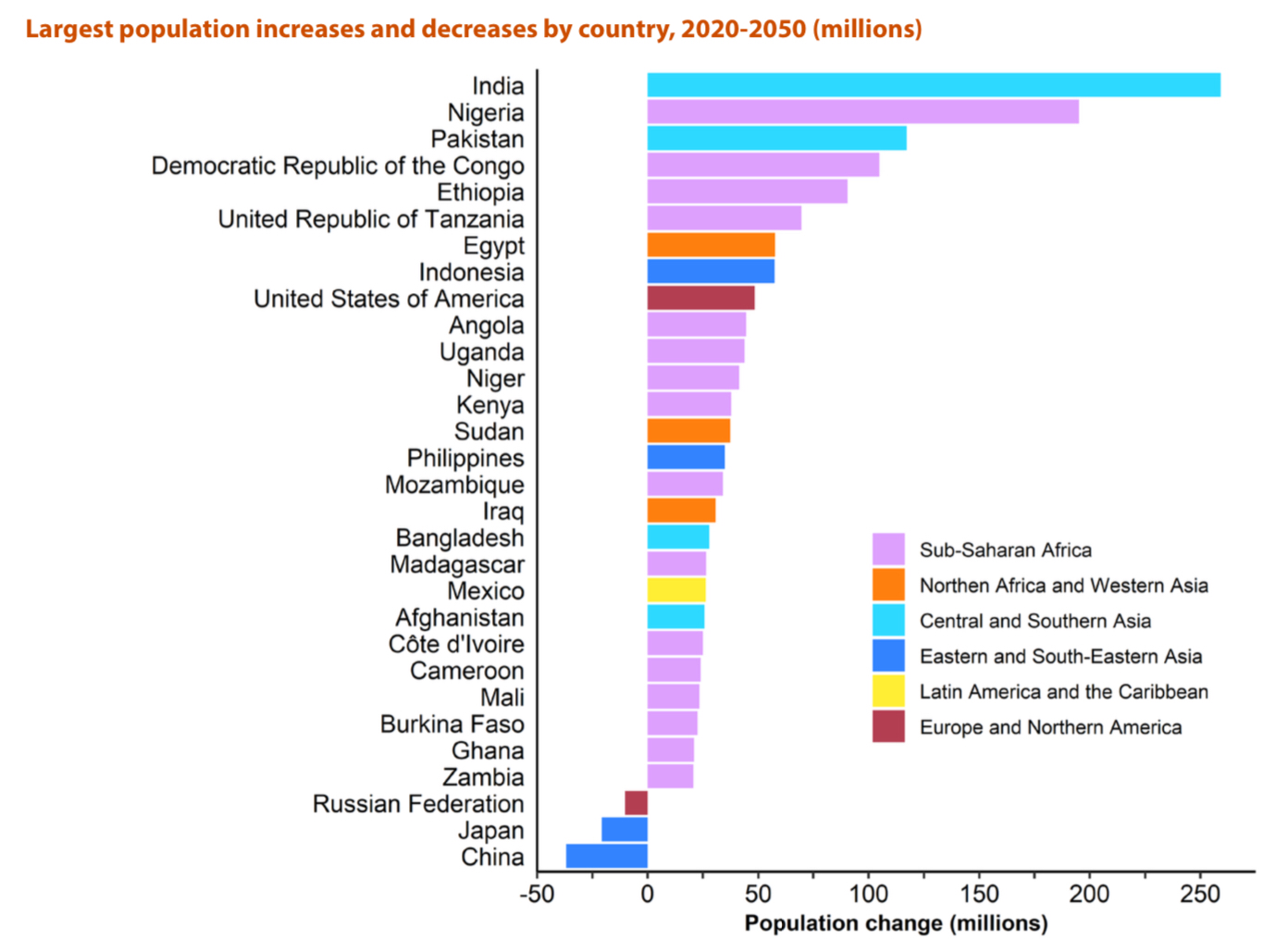
India’s population control measures since Independence
- First Five Year Plan:In 1952, India became the first country in the world to implement a population control programme. It emphasised the use of natural family planning devices.
- Second Five-Year Plan:Work was done in the areas of education and research, with a focus on the clinical approach.
- Third Five Year Plan:The sterilisation technique for both men and women was adopted under the Third Five-Year Plan in 1965.
- The copper- T technique was also used. The Family Planning Departmentwas established as a separate entity.
- Fourth Five-Year Plan:All forms of birth control were encouraged (both traditional and modern).
- Fifth Five Year Plan:The National Population Policy was announced on April 16, 1976, as part of the fifth five-year plan.
- The Sharda Act of 1929set a minimum age for marriage, which was raised under this policy.
- It raised the minimum age for boys to 21 years old and for girls to 14 years old.
- On the basis of the 1971 census, the number of MPs and MLAs was fixed until 2001.
- Forced sterilisationwas permitted under this plan, but it was later abolished.
- The name of the Family Planning Department was changed to Family Welfare Department by the Janata Party government in 1977.

- Sixth to Eighth Five Year Plan:Efforts were made to control population in the Sixth, Seventh, and Eighth Plans by determining long-term demographic goals.
- Ninth Five-Year Plan:In 1993, the government established an expert group to formulate national population policy under the chairmanship of M.S. Swaminathan.
- Despite the fact that this group drafted a new population policy in 1994, it was reviewed by the Family Welfare Department in 1999 and passed by Parliament in 2000.
- In February 2000, the central government released the "new national population policy."
National Population Policy, 2000
- During the twentieth century, India's population increased nearly fivefold, from 23 million to 100 million, while the world's population increased nearly threefold, from 200 million to 600 million.
- Population stabilisation is critical for promoting sustainable development with more equitable distribution.
- The National Population Policy, which was announced on February 15, 2000, provided a policy framework for advancing goals and priorities to various strategies in order to meet India's reproductive and child health needs and achieve TFR by 2010.
- The policy's main goal was to address a variety of issues related to maternal health, child survival, and contraception, as well as to make reproductive health caremore accessible and affordable to everyone.
Population & Sustainable Development Goals
- Rapid population growth is a common feature of the demographic transition: For many countries, this transition has already ended, and the population is growing slowly if at all. Eg European countries . While for many others, the demographic transition is still at an early or intermediate stage, and the population is growing rapidly. Eg . Kenya
- Rapid population growth is both a sign of success and a challenge to be met: Rapid population growth is a result of one of the greatest successes of social and economic development: the substantial lengthening of the average human lifespan due to improvements in public health, nutrition, personal hygiene and medicine. It is also the result of a failure to ensure that all people, everywhere, have the knowledge, ability and means to determine whether and when to have children. India is the classic example
- Rapid population growth is both a cause and a consequence of slow progress in development. Rapid population increase can exacerbate the challenge of ensuring that future development is both sustainable and inclusive. Achieving the Sustainable Development Goals, particularly those related to health, education and gender equality, can contribute to slowing global population growth.
- A decline in fertility can create a window of opportunity for accelerated economic growth : In countries with relatively high levels of fertility today, investments in education and health and the promotion of full and productive employment for all, including for women, can significantly increase the positive, but temporary, economic impact of a favourable age distribution created by a sustained decline in fertility (the “demographic dividend”).
- Higher incomes contribute more to environmental degradation than population growth : Rise in per capita income has been more important than population growth in driving increased production and consumption and emissions of greenhouse gases. More affluent countries bear the greatest responsibility for moving rapidly to achieve net-zero emissions of greenhouse gases and for implementing strategies to decouple human economic activity from environmental degradation.
Solutions to counter overpopulation
- Encouraging late marriages: Many in Indian society opt for early marriages due to various reasons like social pressures, traditions, etc. If late marriages become the norm, it will considerably reduce the birth rate.
- Women empowerment: Women must be empowered through education, skill development, financial inclusion so that they can become independent and free from the shackles of the social norms and constraint.
- Government schemes on par with efficient family planning: Many opt for having children for the purpose of security during the later stage of life. If the government provides enough security through increased welfare schemes for the older population, people will opt for far lesser children.
- Promotion of the girl child : India is a society where the male child has far more importance than their female counterparts. Therefore many families tend to continue having children until a male child is born.Govt policies must focus on the increased promotion of female children to address this problem . Beti Bachao, Beti Padhao is a step in the right direction.
- Govt must increase its investment in health sector. Current India invest only 1.3% of its total GDP on the health sector of which only 4% is dedicated to family planning.
- Govt must address the issue at the ground level as population growth rates differs at various parts of the country due to social, cultural and economic diversity of India.
Where to use?
Paper I (General Studies): Demography
Paper I (Geography Optional): World Population Problems, Planning for sustainable development,
Pollution, tropical cyclones affect rains in India
Why in news? Decline in Indian Monsoon rainfall over past decades down to rise in pollution and Pacific cyclones
About:
- According to Indian Institute of Tropical Meteorology , Pollution and the rise in tropical cyclones over the West Pacific could be a cause for the decline in rainfall and Indian monsoons over the past decades.
- Greenhouse gas emissions and other human-induced activities can significantly alter monsoon flow patterns over the tropical Indo-Pacific Oceans and also lead to an increase in tropical cyclones over the West Pacific.
- Rise in the frequency of tropical cyclones over the Pacific, in turn, can cause a weakening of the Indian monsoon since it is linked with moisture depletion over the Indian subcontinent.
- Human-induced pollution showed a connection with the declining monsoon signals in India. High levels of aerosols in the atmosphere can deflect the Sun’s heat back into space rather than warming the Earth’s surface. This leads to a decrease in temperatures and ultimately reduces rainfall.
- The study pointed out periods of monsoon ‘breaks’ over India coincided with the movement of the cyclones over to the north of a certain latitude range in the west-north Pacific. Citing the example of the record-breaking number of 18 such cyclones that occurred over the west-north Pacific during 2018, researchers said that that India experienced deficient monsoon rains that season.
- Any changes in the Indian summer monsoon can influence the west-north Pacific cyclone activity and vice versa, and highlights how human-induced pollution is changing our climate patterns.
- Rising marine heatwaves in the Indian Ocean have impacted rainfall in the Indian monsoon, according to a Times of India report. The study found a significant increase in marine heatwaves, aided by rapid warming in the Indian Ocean and strong El Ninos.
- Marine heatwaves used to be rare in the tropical Indian Ocean, but now have become an annual occurrence. Marine heatwaves in the western Indian Ocean and the Bay of Bengal have resulted in drying conditions over the central Indian subcontinent.
- At the same time, there is a significant increase in the rainfall over south peninsular India in response to the heatwaves in the north Bay of Bengal. These changes are in response to the modulation of the monsoon winds by the heatwaves. This study has demonstrated a close link between marine heatwaves and atmospheric circulation and rainfall.
Where to use ?
Paper I (Geography optional): Atmospheric circulation, Cyclones, Global climatic changes, Influence of man on ecology and environment.
Paper II (Geography optional): Environmental pollution
Why Hawaii’s volcanoes are different than others?
Why in news? Hawaii’s Mauna Loa, the world’s largest active volcano, began sending up fountains of glowing rock and spilling lava from fissures as its first eruption in nearly four decades.
About:
Where is the magma surfacing at Mauna Loa coming from?
- The magma that comes out of Mauna Loa comes from a series of magma chambers found between about 1 and 25 miles (2 and 40 km) below the surface.
- These magma chambers are only temporary storage places with magma and gases, and are not where the magma originally came from.
- The origin is much deeper inEarth’s mantle, perhaps more than 620 miles (1,000 km) deep.
- Beneath Hawaii, magma can move upward through the cracks to feed different volcanoes on the surface.
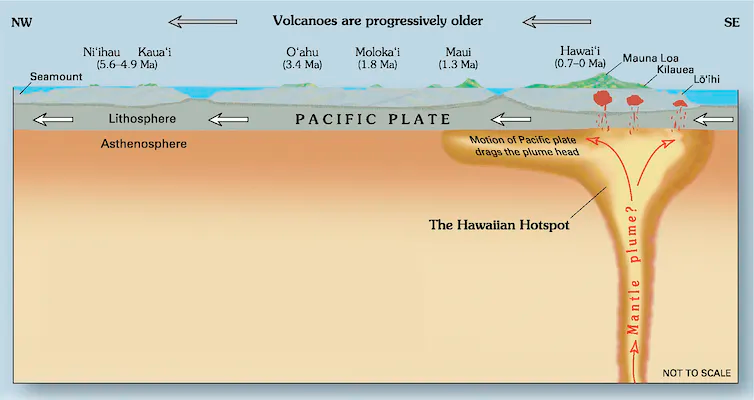
How does molten rock travel from deep in Earth’s mantle, and what exactly is a mantle plume?
- Mantle is not made of uniform rock. Instead, differences in the typeof mantle rock make it melt at different temperatures. Mantle rock is solid at some places, while it starts to melt at other places.
- The partially molten rock becomes buoyant and ascends toward the surface. The ascending mantle rock is what makes a mantle plume.
- Because the overlying pressure lessens as the rock ascends, it melts more and more, and eventually collects in the magma chamber. If a large enough opening exists at the surface, and enough volcanic gases have collected in the magma chamber, the magma is forced to the surface in a volcanic eruption.
- Hawaii’s mantle plume comes from deep inside the mantle.
- But the plume is not a straight pipe as some concept figures suggest. Instead, it has twists and turns, originally coming from the southeast, but then turning toward the west of Hawaii as the plume reaches into the shallower mantle. Cracks in the Pacific Plate then channel the magma upward toward the magma chamber beneath the island of Hawaii.
Why does Hawaii typically see less dramatic eruptions than other locations?
- Hawaii is in the middle of an oceanic plate. In fact, it is the most isolated volcanic hot spot on Earth, far away from any plate boundary.
- Oceanic magma is very different from continental magma. It has a different chemical composition and flows much more easily. So, the magma is less prone to clog volcanic ventson its ascent, which would ultimately lead to more explosive volcanism.
How do scientists know what is happening under the surface?
- The perhaps simplest to understand is GPS. The way scientists use GPS is different from that of everyday life. It can detect minuscule movements of a few centimeters.
- On volcanoes, any upward movement on the surface detected by GPS indicates that something is pushing from underneath.
- Any change in the tilt on a volcano slope indicates that the volcano is “breathing,” again because of magma moving below.
- Other ways that volcanic activity is monitored includes chemical analysis of gases coming out through fumaroles— holes or cracks through which volcanic gases escape. If the composition changes or activity increases, that’s a pretty clear indication that the volcano is changing.
Where to use?
Paper I (General Studies): Important Geophysical phenomenon
Paper I (Geography optional): Vulcanicity, Endogenetic and Exogenetic forces
Madden-Julian Oscillation:
MJO can be defined as a disturbance of clouds, wind and pressure, moving eastward at a speed of 4-8 metres per second, MJO goes around the globe in 30-60 days on average. Sometimes, it can take 90 days. It’s a traversing phenomenon and is most prominent over the Indian and Pacific Oceans. Recently , it was reported that the three year La Niña event ended in March 2023.
Monotremes:
They are mammals that reproduce by laying eggs. They are endothermic but have unusually low metabolic rates and maintain a body temperature lower than most of other mammals. Scientists at the Council of Scientific & Industrial Research - Centre for Cellular and Molecular Biology (CSIR-CCMB) have isolated an anti-microbial protein found in the milk of Echidnas, an egg-laying mammal ( Monotremes )
Ocean colour Monitor:
It is an 8-band multi-spectral camera operating in the Visible – Near-infrared spectroscopy spectral range. is an 8-band multi-spectral camera operating in the Visible – Near-infrared spectroscopy spectral range. It is the first instrument to take advantage of pushbroom technology for achieving higher radiometric performance and higher spatial resolution for ocean observations. Recently ISRO releases images of Earth captured by its EOS-06 satellite through ocean colour monitor
Walker circulation:
It is an atmospheric system of air flow in the equatorial Pacific Ocean. The trade winds across the tropical Pacific flow from east to west: air rises above the warm waters of the western Pacific, flows eastward at high altitudes, and descends over the eastern Pacific. A weaker Walker circulation (in the reverse direction) occurs over the Indian Ocean.
Ice memory:
It is an international Research Project, recognized by UNESCO, which aims to preserve a testimony from current glaciers, threatened by global warming, for future generations. The project aims to collect ice cores from glaciers all over the world and to store them in a library to preserve the information that such real archives of past eras can provide. Scientists from Italy, France, and Norway have set up camp in Norway’s Svalbard archipelago to extract samples of ancient ice for analysis before the frozen layers melt away due to climate change.
SERICULTURE – A VIABLE OPTION FOR RURAL LIVELIHOOD IN JAMMU & KASHMIR
- Sericulture occupies a place of pride in rural economy of Jammu & Kashmir. More than 3000 families are drawing sustenance through this.
- Frequent border disturbances does not allow farmers to venture out in open fields for longer durations.
- Sericulture has very small gestation period and mostly being an indoor activity , that can help in the sustenance of disadvantaged sections, while improving their socio economic status by way of increased employment generation , better remuneration and women empowerment besides enriching the environment for peace & prosperity.
- It is also well suited to the agrarian economy of the tribals as well.
- 2500 sericulture villages are actively involved in the profession of Sericulture.
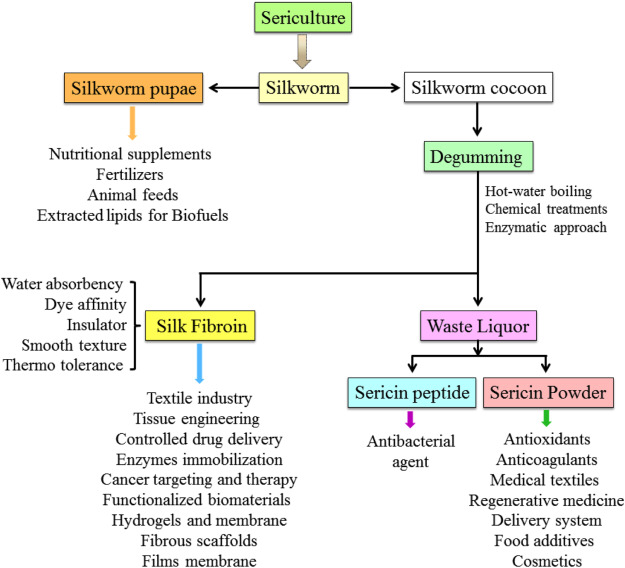
Where to use ?
Paper II (Geography optional): Agro based industries
Map
- Dandeli Anshi Tiger reserve: It sprawls over 875 sq. km. in the Western Ghats in the Uttara Kannada district. The Kali river and its tributaries, Kaneri and Nagajhari, flow through this forest. The park is in the ecoregions of North Western Ghats montane rain forests and North Western Ghats moist deciduous forests, both of which are deemed endangered by the World Wide Fund for Nature (WWF). (Approx. Karwar)
- Hirabuddini: These are the mines in Jharkhand . Currently, India has three working gold mines in the country -- Hutti and Uti mines in Karnataka and the Hirabuddini mines in Jharkhand. Recently , Geological Survey of India has reported three more gold mines in Odisha.( Singhbhumi)
- Rumtek: Rumtek Monastery, also called the Dharma Chakra Centre, is a gompa located in the Indian state of Sikkim near the capital Changchub Dorje was in charge of its construction (12th Karmapa Lama in the mid-1700s). Recently delegates of G 20 visited the Rumtek monastery. (Approx. Gangtok)
- Punnamada Lake: Punnamada lake, also called Punnamada Kayal is one of the elements of Vembanad backwaters, which is known as the longest lake in India. The Lake surrounds three captivating islands of Kerala, which are Pathiramanal, Perumbalam, and Pallippuram. . Recently a boat race was held in the lake. (Approx. Vembanad lake)
- Suketi: Suketi is a village in Sirmaur District of Himachal Pradesh, India. It has Asia's oldest Fossil park “ Shivalik Fossil Park “. Under Mera Gaon Meri Dharohar‘ (My Village My Heritage) programme of the National Mission for Cultural Mapping (NMCM), Suketi has been recognised as the historical village. (Approx)
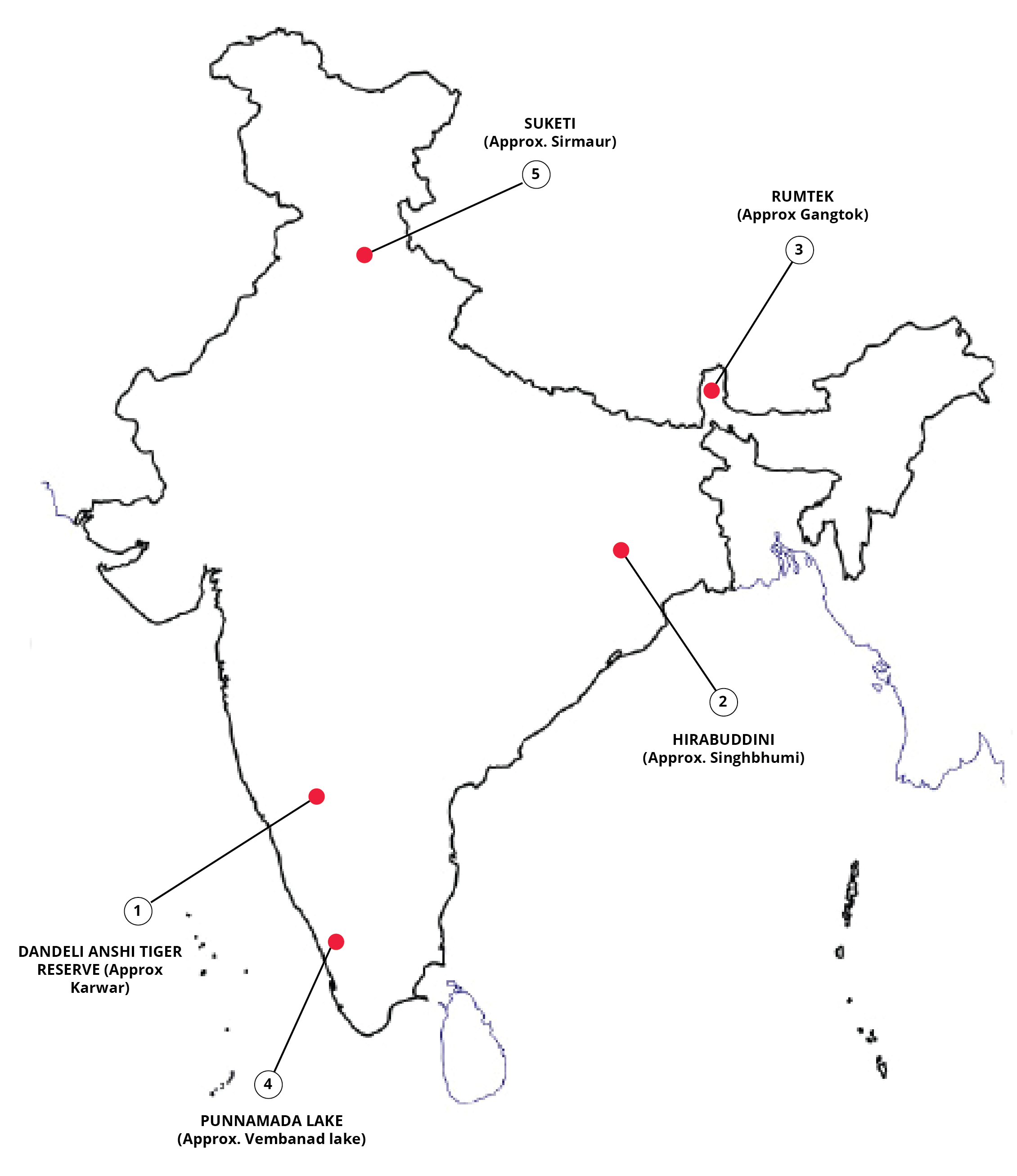
Fortnightly KOSMOS MCQ PRACTICE
1. Consider the following statements regarding Walker Circulation :
- It is caused by the pressure gradient force that results from ahigh pressure system over the eastern Pacific ocean, and a low pressure system over Indonesia.
- Stronger Walker circulation produces El Niño causing droughts in Australia
Which of the above mentioned statements is/ are correct?
- Only 1
- Only 2
- Both 1 and 2
- Neither 1 nor 2
2. With reference to Gulf of Mannar , consider the following statements:
- It is India’s first Marine National Park created in 1980
- World’ rarest Marine animal “ Vaquita “ is found here.
- The inhabitants are mainly Marakeyars, local people principally engaged in fisheries
Which of the above mentioned statements is/ are correct ?
- 1 and 2 only
- 3 only
- 2 and 3 only
- 1 , 2 and 3
3. Consider the following pairs:
Tourist destination. : State
- Nohkalikai Falls. : Mizoram
- Rumtek Monastery. : Arunachal Pradesh
- Phawngpui National Park: Assam
Which of the above mentioned pairs are correctly matched ?
- Only one pair
- Only two pairs
- Only three pairs
- None of the above
4.With reference to Short Beaked Echidnas, consider the following statements:
- They cannot pantlike dogs or sweat like humans, but they use their quills to regulate their body temperature.
- They are theegg-laying mammal known as Monotremes
Which of the above mentioned statements is/ are correct ?
- Only 1
- Only 2
- Both 1 and 2
- Neither 1 nor 2
5.With reference to Tiger Census 2022, consider the following statements:
- The genetically unique andsmall population of tigers in Shivaliks is highlighted as being of high conservation priority.
- Tiger occupancy in the Western Ghats declined, especially in Bilgiranga hills.
Which of the above mentioned statements is/ are correct ?
- Only 1
- Only 2
- Both 1 and 2
- Neither 1 nor 2
6.With reference to Dibang Wildlife Sanctuary, consider the following statements:
- It is characterised by temperate broad-leaved forests and alpine vegetation at higher altitudes.
- This particular Sanctuary is also famous for the Hornbills.
- The people living around the sanctuary belong to theNyishi community.
Which of the above mentioned statements is/ are correct?
- 1 and 2 only
- 1 only
- 2 and 3 only
- 1 and 3 only
7. Consider the following statements regarding River Rejuvenation:
- Dynamic rejuvenation may be caused by the epeirogenic uplift of a land mass.
- Eustatic rejuvenation results from worldwide decrease in sea level.
Which of the above mentioned statements is/ are correct ?
- Only 1
- Only 2
- Both 1 and 2
- Neither 1 nor 2
8. Recently a term “ Cellular Agriculture “ in news is associated with which among the following:
- Crops and plants are grown in a soil-free, layered and vertical environment.
- Concept that focuses on improving farmland and productivity by increasing biodiversity, enriching the soiland regenerating the land.
- Combining technology with livestock and crop science to improve agricultural productivity.
- Growing animal-based products, such as meat, dairy, and seafood, from indirectly from animals
9. Recently , a new species of frog named Amolops Siju known for their preference for small waterfalls have been discovered from which among the following places ?
- Andaman & Nicobar islands
- Kerala
- Meghalaya
- Lakshadweep
10. With reference to Sunderbans , consider the following statements:
- Sunderbans mangroves usually have pneumatophores or breathing roots.
- The eastern part of Sunderbans mangrove is bordered by the Meghna river.
Which of the above mentioned statements is/ are correct ?
- Only 1
- Only 2
- Both 1 and 2
- Neither 1 nor 2
11. Consider the following statements regarding Mangrove Pitta Bird :
- The highest concentration of these birds was found in the mangroves near the Mahipura river mouth inside the Bhitarkanika National Park.
- Its range extends from India to Arab and Europe.
- The bird is aground forager and tree rester.
Which of the above mentioned statements is/ are correct ?
- Only 1 and 2
- Only 2 and 3
- Only 1 and 3
- All of the above
12. With reference to Tea Mosquito Bug , consider the following statements:
- Tea Mosquito Bug damages the plants by inserting eggs into their tissues.
- They damage tea plants by extracting plant juices from developing buds and foliage.
Which of the above mentioned statements is/ are correct ?
- Only 1
- Only 2
- Both 1 and 2
- Neither 1 nor 2
13. Consider the following statements regarding Wildlife Protection Act , 1972
- The act paved the way for the formation of the central authority called Central Zoo Authority.
- It has eight schedules which give varying degrees of protection
- It helped India become a party to the Washington Convention
Which of the above mentioned statements is/ are correct ?
- Only 1 and 2
- Only 2 and 3
- Only 1 and 3
- All of the above
14. Consider the following statements regarding Marine Pollution :
- The North Pacific Gyreis also referred to as the Great Pacific Garbage Patch.
- The goal of Geneva convention is to encourage effective regulation of all causes of marine pollution.
Which of the above mentioned statements is/ are correct ?
- Only 1
- Only 2
- Both 1 and 2
- Neither 1 nor 2
15. With reference to recently released State of World Population report 2023, consider the following statements:
- 25% of India's population is in the age group of 0-14 years.
- In India, 26% are in the age bracket of 10-24 years and only 7% are above 65 years of age.
- 68% of India’s population are in the 15-64 years age group,
Which of the above mentioned statements is/ are correct?
- 1 and 2
- 2 and 3
- 1 and 3
- All of the above
Share the article
Edukemy’s Current Affairs Quiz is published with multiple choice questions for UPSC exams
MCQ
Get Latest Updates on Offers, Event dates, and free Mentorship sessions.

Get in touch with our Expert Academic Counsellors 👋
Frequently Asked Questions
Geography Current Affairs focuses on the contemporary issues, events, and developments in the field of geography. It covers recent geographical phenomena, environmental changes, geopolitical shifts, and related news. This differs from regular geography studies which may focus more on foundational concepts, historical contexts, and theoretical frameworks.
Updates are provided regularly to ensure that subscribers stay informed about the latest developments in geography. Typically, updates are provided on a fortnightly basis, depending on the frequency of significant events and changes in the field.
Absolutely. Geography Current Affairs serves as a valuable resource not only for Geography optional but also for GS papers, especially GS Paper 1 (covering Indian Heritage and Culture, History, and Geography of the World and Society) and GS Paper 3 (covering Technology, Economic Development, Biodiversity, Environment, Security, and Disaster Management). It aids in building a holistic understanding of various topics and strengthens answer-writing skills by incorporating contemporary examples and perspectives.
Geography Current Affairs holds immense importance for UPSC preparation, particularly for aspirants opting for Geography optional. It helps candidates stay updated with the latest developments, geographical phenomena, environmental issues, and geopolitical shifts worldwide, aligning them with the dynamic nature of the subject as tested in the UPSC examinations.


